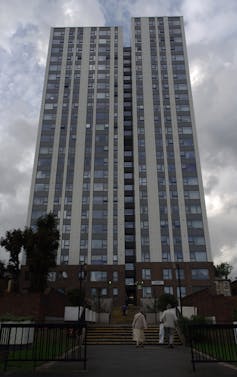
Paresh Wankhade, Edge Hill University
The long-awaited phase one report of the public inquiry led by Sir Martin Moore-Bick into the fire at the Grenfell Tower has been published. This report examines the events of an extremely complicated situation on the night of June 14, 2017, which resulted into the tragic loss of 72 lives. It investigates the cause of the fire, how it developed and the steps taken by the London Fire Brigade (LFB) and other emergency services.
Understandably, the response to the findings – which underscore failures by emergency services – has been immediate and intense, with survivors calling for the resignation of London Fire Brigade chief Dany Cotton. Yet the report runs over 830 pages, and it will take time to examine and understand the findings in detail. For now, I’ve drawn on my expertise in the management of emergency services to summarise the report’s key findings and recommendations.
1. Require owners and managers to share information about building design and materials.

While the report was critical of the fact that LFB was unaware of the combustible nature of the materials used in the external cladding that surrounded Grenfell Tower, it concluded that the cladding was largely responsible for the fire spreading so quickly.
The report recommends that owners and managers of every high rise residential building (over 18 metres in height) should provide their local fire and rescue service with information about the design of its external walls and details of the materials of which they are constructed. This is a significant recommendation, which should help local fire services to recognise the nature of each fire they face, and make contingency plans to deal with specific types of fires.
2. Develop national guidelines for the evacuation of high rise towers.
Moore-Bick praised the firefighters who attended the tower for their extraordinary courage and selfless devotion to duty, but concluded that the absence of an operational evacuation plan was a “major omission” in the LFB’s preparation for a fire at a building such as Grenfell Tower.
The report argued in length whether the “stay put” policy – whereby tower block residents were advised to stay inside their flats, to compartmentalise the fire – could have been reviewed by the brigade earlier in the night, so that more lives could be saved. This is undoubtedly one of the most emotive and controversial issues brought up by the report.
The report also called for a legal requirement on owners and managers of every high rise residential building to draw up evacuation plans and need for contingency planning, including speakers and siren systems, to alert residents to understand the evacuation drill when needed. This may prove more difficult to implement, especially in tower blocks with single staircases. Fears for the safety of elderly people and young children in such scenarios may require the government to bring in new laws to specify planning requirements for the number of stairs and lifts.
3. Improve the response, training and communication within the fire service.
The report was critical about the response of LFB, both on the ground and in the control room where 999 calls were handled – especially regarding how information from callers was processed and shared with ground commanders. The inquiry found that senior control room staff lacked the training to manage a large-scale incident, while operational commanders lacked the training to recognise the need for an evacuation – or organise one.
The report concluded with recommendations to improve call handling and staff training, and develop better communication channels between staff on the ground and and in the control room to facilitate direct communication. It also recommended providing an integrated system of recording fire safety guidance information.
4. Strengthening cooperation between police, fire and ambulance services.
The report also identified lack of coordination between the three emergency services (the LFB, police and ambulance), particularly in the “area of communication between control rooms” and in relation to the “advice to be given to callers” trapped in the tower.
Their failure to share declarations of a major incident – which calls for extra levels of command, control and coordination between emergency services – went against protocols and hampered a joint response between police, fire and ambulance services.
What lies ahead
The report identified massive communication and command challenges for the LFB – and makes a compelling case for organisational learning across the emergency services. My own research has also identified governance challenges and a lack of coordination between emergency services – as did the Kerslake Report on the Manchester Arena tragedy of May 2017. So clearly, these are persistent problems.
Read more: How to reboot Britain’s fractured emergency services
Giving staff proper training, re-assessing the way decisions are made and undertaking rigorous risk assessments – as recommended by the inquiry – will go a long way to reassure the public about fire safety in high rise buildings, and the conduct of emergency services. But it will require additional investments in the services, which are already grappling with spending cuts.
Fire services alone have witnessed a 12% spending reduction in real terms between 2010 and 2015.
Doing “more with less” is also proving difficult for ambulance services.
And central government funding to police and crime commissioners has been reduced by £2.3 billion (25%) in real-terms between 2010-11 and 2015-16.
Phase one of the report has been revealing, but the public will be in a better position to exercise judgement after phase two of the inquiry has run its course, and identified the aspects of the “design, construction and management of the building that were primarily responsible for the disaster”.
Paresh Wankhade, Professor of Leadership and Management, Edge Hill University
This article is republished from The Conversation under a Creative Commons license. Read the original article.
